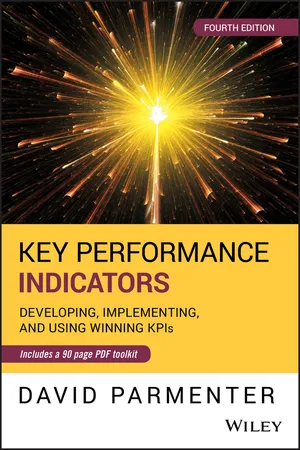
Key Performance Indicators
Developing, Implementing, and Using Winning KPIs
- English
- ePUB (mobile friendly)
- Available on iOS & Android
About this book
The new edition of the bestselling guide on creating and using key performance indicators—offers significant new and revised content
Key Performance Indicators (KPIs) help define and measure the organizational goals which are fundamental to an organization's current and future success. Having solid KPIs is crucial for companies that are implementing performance management systems, such as balanced scorecards, six sigma, or activity-based management. In many organizations, KPIs are often too numerous, randomly assembled, and overly complex—essentially rendering them ineffectual, or at worse, counterproductive. Key Performance Indicators provides a model for simplifying the complex areas of KPIs while helping organizations avoid common mistakes and hazards.
Now in its fourth edition, this bestselling guide has been extensively revised and updated to incorporate practical lessons drawn from major implementations. Fresh content includes a more concise KPI methodology with clear implementation guidance, original insights on how other areas of performance management can be corrected, and new in-depth case studies. A revised starter kit is included toidentify critical success factors, and the KPI resource kit contains updated worksheets, workshop programs, and questionnaires. Helping readers to better define and measure progress toward goals, this important guide:
- Dispels the myths of performance measurement and explains a simple, yet powerful KPI methodology
- Explains the 12-step model for developing and using KPIs with guidelines
- Helps readers brainstorm performance measures, sell KPI projects to the Board and senior management, and accurately report performance
- Features the "KPI Project Leaders Corner" which provides readers with essential information and useful exercises
- Includes an array of practical tools—templates, checklists, performance measures—and a companion website (www.davidparmenter.com)
Key Performance Indicators: Developing, Implementing, and Using Winning KPIs, 4 th Edition is important resource for C-suite executives, senior management, project teams, external project facilitators, and team coordinators involved in all aspects of performance management systems.
Frequently asked questions
- Essential is ideal for learners and professionals who enjoy exploring a wide range of subjects. Access the Essential Library with 800,000+ trusted titles and best-sellers across business, personal growth, and the humanities. Includes unlimited reading time and Standard Read Aloud voice.
- Complete: Perfect for advanced learners and researchers needing full, unrestricted access. Unlock 1.4M+ books across hundreds of subjects, including academic and specialized titles. The Complete Plan also includes advanced features like Premium Read Aloud and Research Assistant.
Please note we cannot support devices running on iOS 13 and Android 7 or earlier. Learn more about using the app.
Information
CHAPTER 1
The Great KPI Misunderstanding
Overview
- Clarity over the different types of measures, result indicators and performance indicators
- The definition of a KPI
- British Airways late planes KPI story
- The seven characteristics of KPIs
- The 10/80/10 rule
- The lead or lag debate is finally buried
- The need to have more current- and future-oriented measures that act like a fence at the top of the cliff
- Avoid measuring too much and measuring too late
The Four Types of Performance Measures
- Key result indicators (KRIs) give the board an overall summary of how the organization is performing.
- Result indicators (RIs) tell management how teams are combining to produce results.
- Performance indicators (PIs) tell management what teams are delivering.
- Key performance indicators (KPIs) tell management how the organization is performing 24/7, daily, or weekly in their critical success factors, and by taking action management is able to increase performance dramatically.
Key Result Indicators
- Net profit before tax
- Net profit on key product lines
- Customer satisfaction (by customer group, showing the trend over an 18-month period)
- Return on capital employed
- Employee satisfaction (by groups showing the trend over an 18-month period)
- Availability of the major services that are offered, e.g., average waiting time for service
- On-time implementation of infrastructure projects
- Membership numbers (for professional organizations)
Table of contents
- Cover
- Table of Contents
- About the Author
- Acknowledgments
- Introduction
- CHAPTER 1: The Great KPI Misunderstanding
- CHAPTER 2: The Myths of Performance Measurement
- CHAPTER 3: Background to the Winning KPI Methodology
- CHAPTER 4: Leading and Selling the Change
- CHAPTER 5: Getting the CEO and Senior Management Committed to the Change
- CHAPTER 6: Up-Skill In-House Resources to Manage the KPI Project
- CHAPTER 7: Finding Your Organization's Critical Success Factors
- CHAPTER 8: Characteristics of Meaningful Measures
- CHAPTER 9: Designing and Refining Measures
- CHAPTER 10: Reporting Performance Measures
- CHAPTER 11: Ongoing Support and Refinement of KPIs and CSFs
- CHAPTER 12: Implementation Case Studies and Lessons
- APPENDIX
- Index
- End User License Agreement